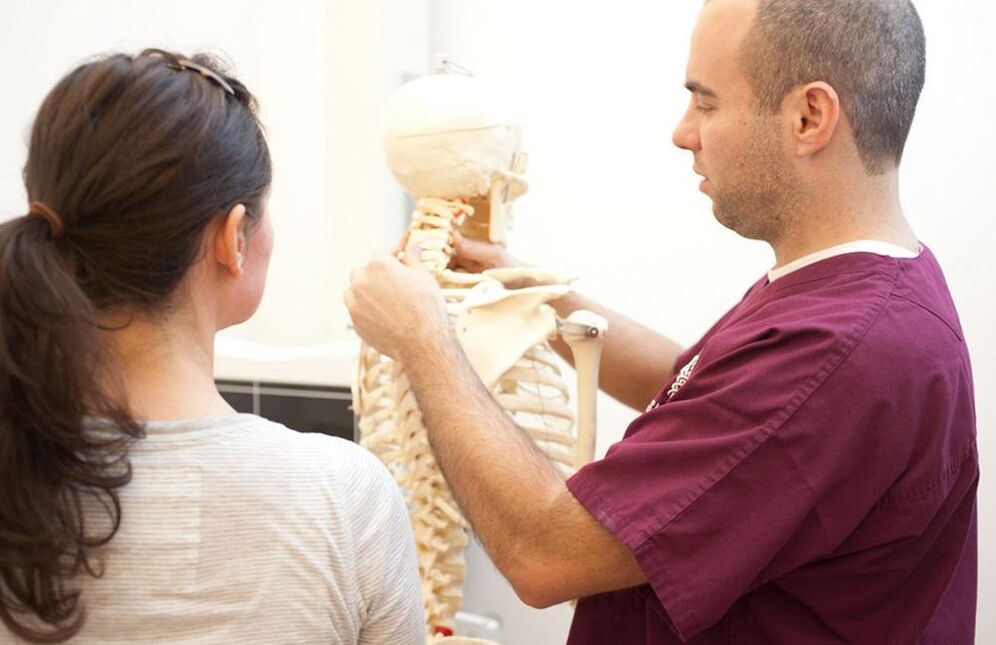
In this article, we will look at the symptoms and treatment of cervical lumbar osteochondrosis. What is this pathology? How does it show itself?
Osteochondrosis is practically the most common disease in the world. After the age of 30, many people suffer from this pathology in various forms. There is also a tendency to rejuvenate the disease, that is, to lower the age limit. This may be due to the fact that most of the people who are currently working are sitting and leading a sedentary lifestyle. By the way, such a disease is dangerous, and everyone should know what cervical osteochondrosis is, how it looks, how to treat it and how to recognize its symptoms.

The main causes of the disease
In a person, the vertical placement of the spine is designed to cause the vertebrae to compress more over time and to gradually break down and deform the bone and cartilage tissue.
The spine always starts in the cervical region with seven vertebrae. This is a particularly sensitive part, as mobility has increased in this area. Such a disease of the cervical spine is primarily reflected in the discs themselves, because they are a weak point of the spine.
Factors such as the small size of the vertebrae and the relative weakness of the neck muscles contribute to the incidence of degenerative disc disease in the cervicothoracic region. In addition, poor blood supply to cartilage tissue affects the developing disease. What does all this mean?
Therefore, the development of this disease seems to be a long and complicated process, the cause of which is very difficult to recognize. Although there is a link between a sedentary lifestyle and osteochondrosis of the cervicothoracic spine, a similar disease occurs in trained people, especially athletes, due to the increased load on the cervical spine. They lift various weights (barbells, weights) that cause deformation of the discs. Therefore, everything needs a measure.

In the elderly and the elderly, as a rule, such damage to the spinal structures is an inevitable process, which in turn is associated with aging and a weakened immune system. However, there may be a pathological type of cervical spine osteochondrosis, the symptoms of which are caused by internal or external adverse factors. These include:
- various spinal injuries;
- rachiocampsis;
- heavy weight;
- incorrect posture;
- hypodynamics;
- heavy physical work;
- impaired metabolic processes;
- hypothermia;
- overwork, stress;
- infectious diseases;
- heredity;
- congenital pathologies or special features of body structure.
Stages of cervical lumbar osteochondrosis
There are four stages of pathology. Sometimes it is very difficult to determine the stage of the disease in a patient according to the general analysis, because in most cases the level of bone tissue damage does not coincide with the symptoms observed in the patient.
The first stage of the disease
At this stage, destructive movements are already taking place in the spine. However, the symptoms of cervical osteochondrosis are still not very clear. People do not notice them or do not associate these symptoms with spinal disease, which they call stress or normal work.
The second stage of the disease
As already mentioned, the symptoms and treatment of cervical osteochondrosis are closely related.
At this stage, the disc becomes significantly thinner and cracks appear on the surface. At this stage, the symptoms of cervical osteochondrosis are constant pain, numbness of the face, weakness.

The third stage
How do the symptoms of cervical lumbar osteochondrosis manifest themselves at this stage? Herniated discs form, affecting the cervical veins and muscles. The person feels dizziness and pain in the back of the head.
The fourth stage of the disease
Osteophytes with cervical lumbar osteochondrosis are common - they cause nerve compression as a result of the proliferation of bone tissue that protects the spine from stress. It is characterized by stiffness of movement and damage to adjacent joints.
Symptoms of cervical osteochondrosis
The main symptoms of cervical spine osteochondrosis are:
- Acute pain in the shoulders and neck.
- Muscle weakness.
- Increased sweating.
- Disruption of coordination.
- Mismatch in hands.
- Dizziness.
- Hypertension.
- Decreased hearing and vision.
- Headache.
These frequent symptoms of cervical lumbar osteochondrosis can manifest themselves at all stages of the disease. In most cases, only a few symptoms appear from this list, and the rest may disappear completely. The patient who encounters them for the first time is practically not diagnosed with cervical osteochondrosis. In this case, you can consult different doctors - cardiologists, neurologists, therapists, surgeons. And in the end, a reliable diagnosis can be determined with a significant delay.
Pathological danger
Not everyone knows the symptoms and treatment of cervical osteochondrosis.
The earliest symptoms of osteochondrosis may appear at the age of 20, and although the pain and discomfort are mild, many people decide to wait for the symptoms to pass, delay a visit to the doctor, and not start treatment. Symptoms in the early stages of osteochondrosis may indeed go away on their own, but the disease will not go away. If left untreated and treated, osteochondrosis can develop further and can be dangerous to human health.

What are the dangers of cervical spine osteochondrosis?
In the first stage, the symptoms are mild, so most people prefer not to take the disease seriously. However, if the patient does not start treatment at the beginning of development, it can lead to dangerous, serious complications. The result of an indifferent stage is a situation in which a person is unable to perform his functions. This can often be accompanied by lesions in adjacent branches. Such abandoned osteochondrosis can lead to very dangerous consequences, and then disability.
In addition, you can develop:
- swelling of the intervertebral discs;
- protrusions and intervertebral hernias;
- disk loss;
- lumbago or sciatica;
- spinoses of the spinal canal.
In special cases, the diseases listed above are forced into surgery, and the result of an advanced stage is disability.
The problems listed above are specific to cervicothoracic lumbar osteochondrosis.
Complications of the disease
The danger of the disease is that the cervical region is connected to the blood vessels that supply blood to the brain. Outcomes of cervical osteochondrosis include sleep disturbances, migraines, vision problems, and dizziness. With an advanced disease, the listed symptoms will be more noticeable. Problems with cervical osteochondrosis are possible:

- high or low blood pressure and vascular dystonia;
- thyroid disease;
- vestibular disorders;
- hypertension or hypotension;
- stroke;
- epicondylitis;
- humeroscapular periarthrosis.
Diagnosis of cervical spine pathology
Many people are interested in the symptoms and treatment of cervical spine osteochondrosis.
You should consult a therapist for a correct diagnosis. He will consult other specialists - neurologist, vertebrologist, orthopedist.
The following types of research are added to diagnose the disease:
- CT examination;
- radiography;
- MRT;
- Doppler scan.
X-ray shows growths, displacement of vertebrae, salt deposits and osteophytes, disc seals. With the help of computed tomography you can get a fairly large image of the organs, in this case the cervical spine. It will allow to explain in detail the stage of the pathological process, the nature of nerve compression, the height of the discs and the structure of osteophytes. Magnetic resonance imaging shows the structure of the spine in more detail. Ultrasound can help determine how the blood flow in the large blood vessels in the neck is affected.

Treatment of this disease
The symptoms and treatment of cervical spine osteochondrosis are interrelated.
Medicine develops many methods to help a person resist disease. There are also treatments that you can use at home. However, this procedure takes a long time and is unlikely to fully recover, especially in old age. However, it should be noted that at any stage of the disease it is possible to stop and slow down the pathological processes in the spine.
Treatment of cervical lumbar osteochondrosis in the early stages of the disease is mainly conservative. Several methods can be used for therapy:
- physiotherapy;
- medicines;
- massage;
- physiotherapy;
- special devices for straightening the spine.
If such a disease progresses to an extreme stage, if the osteochondral structure of the spine is destroyed, surgery should be performed to treat cervical osteochondrosis.
Drugs for the treatment of pathology
Medications needed to treat cervical spine osteochondrosis:
- analgesics;
- vitamins;
- chondroprotectors;
- anti-inflammatory drugs;
- antispasmodics.
When an acute pain syndrome associated with osteochondrosis occurs, the most important task is to eliminate it. In such cases, oral analgesics are taken, but if the effects are not noticeable, novocaine blockade can be used.
The symptoms and treatment of cervical spine osteochondrosis remain controversial for many.
Antispasmodics are often taken. Muscle relaxants have the greatest effect in osteochondrosis. As painkillers and anti-inflammatory drugs, the patient can use ointments containing non-steroidal drugs.
If there are symptoms associated with impaired blood supply to the brain and vertebral artery syndrome, it is necessary to use drugs that eliminate the unpleasant manifestations - drugs that lower blood pressure and nootropic drugs.
Symptoms and treatment of cervical lumbar osteochondrosis are no longer a mystery.

Physiotherapy exercises
Physiotherapy is the simplest and most accessible form of prevention of cervical osteochondrosis and is also very effective. Physiotherapy can also be done at home. Saturation of classes with cervical osteochondrosis does not play a big role, they just need to be regular. First of all, physical training is designed to strengthen the neck muscles, the task of which is to compensate for the lack of functionality of the spine and to support weakened vertebrae. Treatment of cervical lumbar osteochondrosis should be regular.
You need to do daily exercises to strengthen your muscles. Such exercises can be very simple, including turning and tilting the head in different directions, and involve the hands to help the cervical muscles. It can be done both at home and at work. For example, if you have to work all the time while sitting, it is very useful to do different exercises every hour while sitting at a table and monitor. However, this should be done only when the disease is not exacerbated and there is no pain syndrome. Otherwise, the same exercises can make the situation worse.
It is also effective in treating cervical lumbar osteochondrosis to strengthen the shoulder girdle muscles, for example, use light dumbbells in regular exercise. However, lifting weights like kettlebells or barbells is contraindicated. Regular swimming activities can be helpful as they relieve stress on the spine.
We examined the symptoms and treatment of cervical spine osteochondrosis.














































